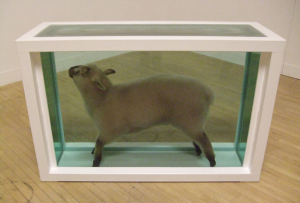
The corresponding author of the 2016 study that found high levels of the carcinogen formaldehyde leaking from a prominent British artist’s exhibition is now retracting it.
The study, about Damien Hirst’s 2012 exhibition at the Tate Gallery in London that presented dead animals embalmed in glass cases full of formaldehyde, suggested that higher than recommended limits of the carcinogen were being released from the exhibition. The study was widely covered by the media, which raised concerns over possible health hazards to visitors.
As we reported yesterday, the journal Analytical Methods had already issued an expression of concern (EOC), noting that the corresponding author of the paper, Pier Giorgio Righetti of the Polytechnic University of Milan in Italy, warned the paper may contain unreliable data.
Today, Righetti released a joint statement with Hirst’s company, Science Ltd, stating that he will be retracting the paper (reported earlier today by the New York Times). It reads:
…the corresponding author of the Paper has unreservedly acknowledged that the Paper is inaccurate and unreliable and has initiated the Journal’s formal procedure for its complete retraction. Furthermore, he regrets any alarm or concern the Paper may have caused.
It goes on to say:
Mr Hirst’s company, Science Ltd, investigated the claims, in the process consulting with Professor of Physical Chemistry at Oxford University, Claire Vallance. Science Ltd and the authors of the Paper cooperated to conduct further tests on formaldehyde artworks using the equipment referred to in the Paper as well as commercially available equipment used by Science Ltd to test the presence of formaldehyde fumes.
The statement adds:
None of the tests showed readings of formaldehyde higher than 0.1 ppm (which is 0.05 ppm above the ambient background level of 0.05 ppm). The recommended maximum exposure level under legislation is 2 ppm. The cause of the discrepancy with the readings published in the Paper was identified and it was agreed that there cannot have been formaldehyde present at the dangerously high levels originally cited in the Paper and, accordingly, there was never any risk to the public.
The original study said the measurements of formaldehyde — performed using wrist bracelet sensors — reached levels of 5 ppm, levels at which Science Ltd said in a statement issued in April:
…your eyes would be streaming and you would be in serious physical discomfort.
Philippa Hughes, executive editor of Analytical Methods, told us:
Further to the expression of concern we published earlier this week, we are following due process towards retraction, in line with our ethical publishing policy and in consultation with the authors.
When the study was published, Tate also released a statement:
Tate always puts the safety of its staff and visitors first, and we take all the necessary precautions when installing and displaying our exhibitions. These works contained a very dilute formaldehyde solution that was contained within sealed tanks.
We reached out to Righetti, who said he had nothing to add to the joint statement he provided with Science Ltd.
I looked very thoroughly at the testing procedures used by Damien Hirst’s company Science Ltd, at the independent testing they have commissioned, and at the new sensor reported in the paper, we carried out detailed comparative tests of formaldehyde levels near both sealed artworks and open formaldehyde tanks, and I am completely confident that we understand the source of error and that there were no high levels of formaldehyde around the artworks at any stage.
Like Retraction Watch? Consider making a tax-deductible contribution to support our growth. You can also follow us on Twitter, like us on Facebook, add us to your RSS reader, sign up on our homepage for an email every time there’s a new post, or subscribe to our new daily digest. Click here to review our Comments Policy. For a sneak peek at what we’re working on, click here.
I think the question could be,”But is it art?”
Only when it offends large portions of the population is it truly art.
Ha ha, very good. What about boring?
Excellent question and one I’m sure Tate has an answer to even if you and I might think differently.
Well some people ask the question “is it plagarised art?”:
http://stuckism.com/Hirst/StoleArt.html